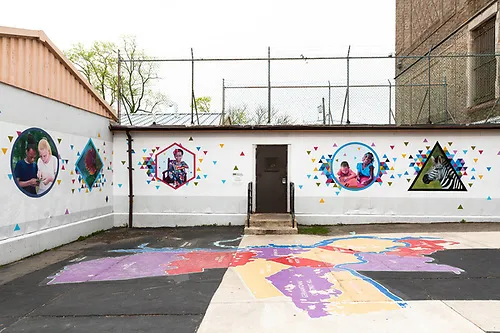Symbiosis

The mural Symbiosis by Kala Hagopian @ HagopianArts is composed of nine 5×5 ft panels that explore the more colorful examples of mutually beneficial relationships. In Africa, plains zebras carry helpful passengers: oxpeckers. These little birds have an obligate symbiotic relationship to sub-Saharan Africa’s herd animals. Oxpeckers live the majority of their lives on the backs of zebra, rhino, giraffes, and impalas, picking off parasites and insects with their specially evolved beaks. In return for their role as walking buffets, the zebra who have an oxpecker guardian are less likely to succumb to infected tick bites, burrowing larvae, and itchy mosquitoes.
Symbiotic relationships can provide protection as well as sustenance. Anemones are polyp organisms that attach to hard surfaces on the seafloor. Their tentacles are armed with cnidocytes, or stinging cells, that stun and poison passing fish and invertebrates. The clownfish, however, is an anemone specialist who makes its home in the poisonous polyp. It’s unclear whether the clownfish coevolved with anemones and developed a genetic immunity, or if they are able to secrete a mucus on their skin that traps stinging cells. While the clownfish receives protection from its predators, they return the favor by cleaning away parasites and dead tentacles.
Plants and insects have symbiotic relationships as well. The most classic example is the honey bee, which spends its life gathering nectar from wildflowers. While reaching for the sugar secretion at the center of a flower, the bees are dusted by pollen. As they move on to the next flower, the pollen is distributed, resulting in cross-pollination and the fertilization of female flowers. Scientists hypothesize that flowers evolved their dashing colors solely to attract insects, using ultraviolet lights like runways to guide passing pollinators.
Symbiotic relationships can occur even after death. Bracket fungi are colorful organisms that occur in step-like patterns on decaying trees. They are part of the polyphore family, which are related to mushrooms. Polyphores like bracket fungi are crucial to a forest’s ability to sustain itself through nutrient cycling. After a tree dies, decomposers break down the dead wood, releasing its nutrients into the soil, providing habitats for small mammals and insects, and creating room for new growth. Polyphores are unique due to their participation both in the death of their symbiont but also in providing space for its rebirth.
Symbiotic relationships can be incredibly complex, and result in our most precious and biodiverse ecosystems on Earth. Treasures like the Great Barrier Reef and the Amazon Rainforest are the product of these relationships and are also examples of environments negatively impacted by human interference. Understanding symbiotic relationships is to understand how important it is for every person to participate in restoring balance to these delicate communities: by curbing our carbon emissions, lessening pollution, and preserving ecosystems at risk.
To read more from the artist about the theme of this mural, go here: https://www.hagopianarts.com/symbiosis

